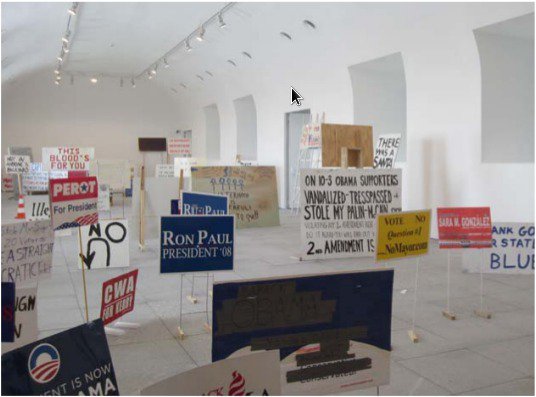Sharon Hayes
dal 29/5/2012 al 23/9/2012
Segnalato da
Museo Nacional Centro de Arte Reina Sofia
29/5/2012
Sharon Hayes
Museo Nacional Centro de Arte Reina Sofia, Madrid
Habla. Hayes has drawn on various media - video, installation and performance - to investigate how speech, politics and history interrelate. Her conceptual and methodological strategies are typically derived from a range of discursive fields, including ethnography, journalism, rhetoric, theatre and dance.

curated by Lynne Cooke
Socially significant themes, most of them inscribed in recent historical events, have
been at the heart of Sharon Hayes’ work since she presented her first public
performances in the mid- 1990s. For constantly at issue in this young American’s art is
the study of the complex relationships that bind history and politics as they register in
individual and collective consciousness. . “I find the idea of unspooling history quite
compelling,” she confesses. Whether commissions for particular exhibitions or self
generated, Hayes’ performances typically explore the conditions under which collective
political and social identifications are constructed. “One of the most significant aspects
of my practice”, she stated several years ago, “[is] an investment in the ways that
events mark themselves psychically and socially in our collective imagination”.
Hayes has drawn on various media – primarily video, installation and performance – to
investigate how speech, politics and history interrelate. Her conceptual and
methodological strategies are typically derived from a range of discursive fields,
including ethnography, journalism, rhetoric, theatre and dance. For her, forms of
embodiment – self-reflexive, differential or collective – serve as vehicles through which
the speaker/dancer and the script/score may be prized apart, so that the means of
conveyance, the performative act, can be more closely scrutinized. “In much of my
work, I embody a given speech act myself”, she explains, “because it is important to
me to stand in a space of responsibility vis-à-vis this respeaking”. Site, too, plays a
crucial role in the conception of most of her works for the public arena; that is, the
actual location(s) in which a work is realized becomes an integral element in shaping
its content: public address and civic space are congruent in the formation of many of
her signature works.
In a number of pieces, Hayes has drawn on pre-existing texts, ranging from
presidential speeches to Patty Hearst’s broadcast as a member of the Symbionese
Liberation Army. When re-speaking words she has learnt by heart, Hayes’ delivery
necessarily incorporates a certain disjunction, a fracture or fissure that initially arrests,
and may then provoke her audience to re-examine the import of events freighted with
historical or cultural import. “For many years now I’ve been interested in how
performance allows for the possibility that you are both doing and not doing what it is
that you seem/look/sound like you’re doing, “ she stated in the interview quoted above.
“Often, for me, this doing and not doing happens through the execution of some kind of
oral translation – taking a speech act that was delivered at one moment in time and re-
speaking or readdressing it in another” For multiple reasons - ethical, conceptual, and
formal - it is critical that she herself is the protagonist in her performances: rarely does
she cast others into roles.
When looking for a title in Spanish (a language she does not speak), for this show
Hayes turned to Ferdinand de Saussure’s “Course on General Linguistics”, a text that
has been formative on her thinking, along with publications by more recent cultural
theorists including Eve Kosofsky Sedgwick and Judith Butler. The nearest equivalent to
“parole” as used by Saussure seems to be “habla”, which Hayes likes not only since it
references an ability or aptitude inherent in everyone - the living habit of a language
system as opposed to/distinct from “langue”, the system itself - but because “habla”
alludes, too, to communication as a means of being in contact, and through that,
implies a sense of community. And, not least, “habla” also functions as an imperative
(second personal singular): “talk”. Her attraction to this word on account of its nuanced
levels of meaning is indicative of her way more generally, of her exigent yet probing
engagement with the performative nature of language in its myriad guises and roles.
Biographical notes:
Sharon Hayes was born in Baltimore (Maryland, USA) in 1970, and studied at
Trinity/LaMama Performing Arts Program in Nueva York (1991), the Bowdoin College
in Brunswick (Maine) (1992), Whitney Museum of American Art Independent Study
Program in Nueva York (1999–2000) and the University of California (2003). She
currently lives and works in New York.
Her performances, videos and installations have been shown in important museums
and festivals throughout the world, such as The Project in Los Angeles (2002), the New
Museum for Contemporary Art in New York (2007), Tate Modern London (2008), the
PS1 MoMA in New York (2010) or the Venice Biennale (2011). She has also
participated in numerous exhibitions and galleries in the United States, Canada,
Colombia, Germany, Austria, Switzerland, Belgium or Croatia.
Museo Reina Sofía included one of her works, In the Near Future (2005) in the
exhibition Mixed Use Manhattan, in 2010.
Related activities:
29 May 20-20.30 Plaza Sánchez Bustillo and Sabatini Terrace (3rd floor): Performance "Estimada señores"
Coinciding with the opening, Sharon Hayes offers a performance at Plaza Sánchez
Bustillo, outside the Museum, and the terrace on the 3rd floor in Sabatini. The action
consists in reciting the text, written by Pablo Sigg, which the artist has previously
memorized, not knowing what is it about or what she is saying.
Image: Yard, 2009, Museo Nacional Centro de Arte Reina Sofia, 2012
Opening May 30, 2012
Museo Nacional Centro de Arte Reina Sofia
Santa Isabel, 52, Madrid
Mon-Sat 10-21, Sun 10-14.30
Admission: 6 euro, 3 concessions



